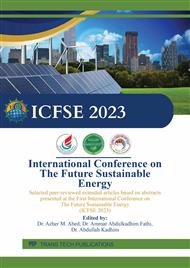[1]
M. Aflori, Smart nanomaterials for biomedical applications, a review - Nanomaterials. (2021).
Google Scholar
[2]
Sudipta De, Alina Mariana Balu, Biomass-Derived Porous Carbon Materials: Synthesis and Catalytic Applications, ChemCatChem, vol. 7, (2015) 1608-1629.
DOI: 10.1002/cctc.201500081
Google Scholar
[3]
R.B. Galvão, A.A. da Silva Moretti, F. Fernandes, E.K. Kuroda, Post-treatment of stabilized landfill leachate by upflow gravel filtration and granular activated carbon adsorption Environ. Technol., (2020).
DOI: 10.1080/09593330.2020.1746838
Google Scholar
[4]
H.F. Stoeckli, Microporous carbon and their characterization, Carbon, (1990).
Google Scholar
[5]
José Luís Figueiredo, Manuel Fernando R. Pereira, in Novel Carbon Adsorbents, (2012).
Google Scholar
[6]
Al-Hashimi, O., Hashim, K., Loffill, E., Marolt Čebašek, T., Nakouti, I., Faisal, A. A. & Al-Ansari, N. A comprehensive review for groundwater contamination and remediation: occurrence, migration and adsorption modelling. Molecules 26 (19), (2021).
DOI: 10.3390/molecules26195913
Google Scholar
[7]
Guofu Ma, Dongyang Guo, Kanjun Sun, Hui Peng, Qian Yang, Xiaozhong Zhou, Xiaolong Zhao and Ziqiang Lei , Cotton-based porous activated carbon with a large specific surface area as an electrode material for high-performance supercapacitors RSC Adv., (2015), 5, 64704.
DOI: 10.1039/c5ra11179j
Google Scholar
[8]
M. Rasapoor, B. Young, A. Asadov, R. Brar, A. K. Sarmah, W.-Q. Zhuang and S. Baroutian, Effects of biochar and activated carbon on biogas generation: a thermogravimetric and chemical analysis approach, Energy Convers. Manage, (2020).
DOI: 10.1016/j.enconman.2019.112221
Google Scholar
[9]
J. Kim, and J. Chung., Production of granular activated carbon from food-processing wastes (walnut shells and jujube seeds) and its adsorptive properties, J. Air Waste Manage. Assoc., (2014).
DOI: 10.1080/10962247.2014.897272
Google Scholar
[10]
K.Yang, Preparation of high surface area activated carbon from coconut shells using microwave heating. Bioresour, Technol. , (2010).
Google Scholar
[11]
I. Ahmed Osman, Jacob Blewitt, Jehad K. Abu-Dahrieh & Charlie Farrell & Ala'a H. Al-Muhtaseb & John Harrison & David W. Rooney, Production and characterisation of activated carbon and carbon nanotubes from potato peel waste and their application in heavy metal removal, (2019).
DOI: 10.1007/s11356-019-06594-w
Google Scholar
[12]
J. B. Njewa, E. Vunain, and T. Biswick, Synthesis and characterization of activated carbons prepared from agro-wastes by chemical activation, Journal of Chemistry, vol. 2022, Article ID 9975444, (2022).
DOI: 10.1155/2022/9975444
Google Scholar
[13]
Sait Yorgun, Naile Vural and Hakan Demiral, Preparation of high-surface area activated carbons from Paulownia wood by ZnCl2 activation, Microporous Mesoporous Mater. , 122, (2009) 189–194.
DOI: 10.1016/j.micromeso.2009.02.032
Google Scholar
[14]
Hsisheng Teng and Hung-chi Lin, Activated carbon production from low ash subbituminous coal with CO2 activation, AIChE J., 44, (1998)1170–1177.
DOI: 10.1002/aic.690440514
Google Scholar
[15]
L. Jillian Goldfarb, Guolan Dou, Maryam Salari, and Mark W. Grinstaff, Biomass-Based Fuels and Activated Carbon Electrode Materials: An Integrated Approach to Green Energy Systems, ACS Sustainable Chem. Eng., 5, 4, (2017) 3046–3054.
DOI: 10.1021/acssuschemeng.6b02735
Google Scholar
[16]
Soheila Faraji and Farid Nasir Ani, The development supercapacitor from activated carbon by electroless plating", Renewable and Sustainable Energy Reviews, vol. 42, (2015) 823-834.
DOI: 10.1016/j.rser.2014.10.068
Google Scholar
[17]
Adekunle Moshood Abioye and Farid Nasir Ani, Recent development in the production of activated carbon electrodes from agricultural waste biomass for supercapacitors, Renewable and Sustainable Energy Reviews, vol. 52, (2015)1282-1293.
DOI: 10.1016/j.rser.2015.07.129
Google Scholar
[18]
Mohd Adib Yahya, Muhammad Humaidi Mansor, Wan Amani Auji Wan Zolkarnaini, et al., A brief review on activated carbon derived from agriculture by-product, AIP Conference Proceedings 1972, 030023 (2018).
Google Scholar
[19]
JM Dias, Alvim-Ferraza MCM, Almeida MF, Rivera-Utrilla J, Sánchez-Polo M. Waste materials for activated carbon preparation and its use in aqueous-phase treatment: A review. J Environ Manage (2007).
DOI: 10.1016/j.jenvman.2007.07.031
Google Scholar
[20]
E. Liu, Shen H, Xiang X, Huang Z, Tian Y, Wu Y, Wu Z, Xie H., A novel activated nitrogen-containing carbon anode material for lithium secondary batteries, Mater Lett (2012).
DOI: 10.1016/j.matlet.2011.09.112
Google Scholar
[21]
S. Rosinski, Lewinska D, Piaztkiewicz W., Application of mass transfer coefficient approach for ranking of active carbons designed for hemoperfusion, Carbon (2004).
DOI: 10.1016/s0008-6223(04)00277-5
Google Scholar
[22]
SY Seo, Choi WS, Yang TJ, Kim MJ, Tran T., Recovery of rhenium and molybdenum from a roaster fume scrubbing liquor by adsorption using activated carbon, Hydrometall (2012).
DOI: 10.1016/j.hydromet.2012.06.007
Google Scholar
[23]
Zheng Y, Shen Z, Cai C et al, The reuse of nonmetals recycled from waste printed circuit boards as reinforcing fillers in the polypropylene composites, J Hazard Mater, (2009).
DOI: 10.1016/j.jhazmat.2008.07.008
Google Scholar
[24]
Mina Oumam, Abdelkrim Abourriche, Said Mansouri and et al, Comparison of chemical and physical activation processes at obtaining adsorbents from Moroccan oil shale, Oil Shale, vol. 37, No. 2, (2020) 139–157.
DOI: 10.3176/oil.2020.2.04
Google Scholar
[25]
Jiazhen Zhou, Anran Luo and Youcai Zhao, Preparation and characterisation of activated carbon from waste tea by physical activation using steam, journal of the air & waste management association, vol. 68, NO. 12, (2018)1269–1277
DOI: 10.1080/10962247.2018.1460282
Google Scholar
[26]
Uçar, S., Erdem, M., Tay, T., & Karagöz, S., Preparation and characterization of activated carbon produced from pomegranate seeds by ZnCl2 activation, Applied Surface Science, (2008).
DOI: 10.1016/j.apsusc.2009.06.080
Google Scholar
[27]
Xu, X., Gao, B., Jin, B., & Yue, Q., Removal of anionic pollutants from liquids by biomass materials, A review. Journal of Molecular Liquids, (2016).
DOI: 10.1016/j.molliq.2015.12.101
Google Scholar
[28]
P. Scherrer, Bestimmung der Grösse und der inneren Struktur von Kolloidteilchen mittels Röntgenstrahlen, Nachr. Ges. Wiss. Göttingen 26 (1918) 98-100.
DOI: 10.1007/978-3-662-33915-2_7
Google Scholar
[29]
J.I. Langford and A.J.C. Wilson, Scherrer after Sixty Years: A Survey and Some New Results in the Determination of Crystallite Size, J. Appl. Cryst. 11 (1978) 02-113.
DOI: 10.1107/s0021889878012844
Google Scholar
[30]
B.D. Cullity & S.R. Stock, Elements of X0Ray Diffraction, 3rd Ed., Prentice-Hall Inc., (2001).
Google Scholar
[31]
Hameed B, Tan I and Ahmad A., Adsorption Isotherm, Kinetic Modeling and Mechanism of 2,4,6-Trichlorophenol on Conconut Husk-Based Activated Carbon, Chem Eng J. (2008) 235-244.
DOI: 10.1016/j.cej.2008.01.028
Google Scholar



